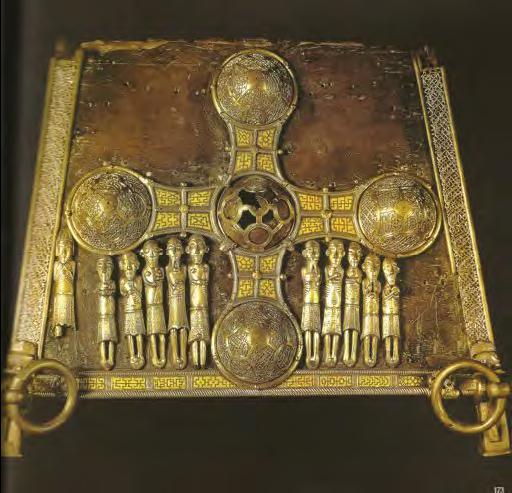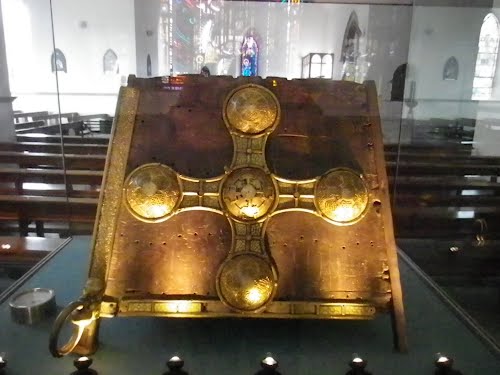
Try Amazon Fresh
Shrine of St. Manchán, of Manghan, c. 1130
Boher church, Co. Offaly, Ireland
 | |
| Large image of figures on left | Large image of figures on right |

Back of the shrine. Picture by Alan L.

 | |
| Large image of figures on left | Large image of figures on right |

Reference: Wall, J. Charles, Shrines of British Saints, Methuen & Co., London. 1905. Chapter Four.
ST. MANCHÁN
The other Irish example is the shrine of St. Manchán, of Manghan, which still contains the supposed relics of a saint of that name—but of which particular Stain Manchán is doubtful. Whether, in fact, it was the actual name of a saint, or whether it is a diminutive of Manach, Monachus, a monk, is difficult to decide. Many were the holy monks of the seventh century in Ireland, and a “Saint Manchán” is commemorated on various days in different martyrologies.
The saint whose relics are preserved in the shrine now to be described was probably the Abbot of Leith, in King’s County, whose death, Colgan records, occurred in 664.5 In the Annals of the Four Masters, under the year 1166, it is chronicled that “the shrine of Manchán, of Mæthail, was covered by Ruaidhri Ua Conehobhair (Rory O’Connor, King of Ireland), and an embroidering of gold was carried over it by him in as good a style as a relic was ever covered in Ireland.”
This description closely agrees with both the age and the art of the reliquary now preserved on the altar of a chapel at Boher, in the parish of Lemanaghan, in which district stand the ruins of Leith Abbey where St. Manchán presided over his community, and after whom the parish is named.
Saved from iconoclastic zealots the shine was long kept in a small thatched building, used as a chapel until it was destroyed by fire, when local tradition asserts that the reliquary was miraculously preserved, it alone being saved unhurt while all else was consumed. It was then placed in the custody of the ancient family of Moony of the Doon, to whose residence the peasantry resorted to take oath on the shine ; but through the inconvenience thus caused it was translated to the church, and remains in the care of the parish priest.
The shine, or feretory, has a rectangular base 23 inches long by 12 inches wide, from which the sides rise without a break to a gable 19 inches high. It is supported by four feet 2 inches in height, which follow the rake of the sides. The two ends are thus of triangle form. The framework is made of yew, which is yet quite sound.
The base of the shrine is surrounded by a border of bronze 1¼ inches wide, ornamented by a tau pattern of Champlevé enamel, between which is engraved a chevron design. The sides have borders of bronze 1½ inches wide, the edges of which are hammered up into cable mouldings, and the flat central bands are filled with a continuous pattern of intricate animal interlacings, pierced through the metal and exposing the timber beneath. On both of the sides is a large cross 18 inches in width and 17 inches in height ; at each extremity and in the centre is a large raise boss, 4½ inches in diameter and 1½ inches in relief, all enriched with interlaced lacertine ornament, except the two central, which were probably enameled. The arms of the crosses are each composed of four enameled plates ; the ground of the enamels is yellow with a border of red lines. Above and below the crosses were originally about fifty-two figures, sixteen below and ten or twelve above the cross on each side ; the figures are in high relief and were heavily gilt, but being fastened to the background by nails of bronze, many of them have fallen away, only ten remaining, all of which, by their vestures, are apparently laymen, mostly warriors. They are habited in close-fitting tunics with an outer covering with sleeves ; a girdle encircles the hips, and from it falls a richly embroidered philibeg, or kilt. The legs and feet are bare. The hair and beard are variously trimmed, and one figure appears to have a steel cap. Four of the figures bear distinctive emblems—on carries an axe, another a book, and two others have short swords.
Two other figures of the same elongated form have been found in the neighbourhood, which from their size and style probably belonged to the shrine of St. Manchán. One of them, with a richly chased conical helmet covering the head and neck, is evidently a chieftain. the other is unmistakably in sacerdotal vestments ; the head is covered by a cap, or primitive mitre, and over a short alb is a chasuble of the same length ; in his hands he grasps a short cambutta, or pastoral staff, and his feet are covered with buskins.
The ends of the shrine are surrounded by borders similar to the sides, but the panels within them are sunk about half an inch and are each covered by a plate of bronze, the entire surface of which is enriched by beautiful interlaced work, divided into two compartments by an elongated monster, which is riveted down to the plate.
The crest of the shrine is lost, and with it probably the names of the donor and artificer, which in Irish work so frequently found a place on the joint production of their combined riches and skill.
Above the feet of panelled bronze are heavy clamps of the same metal, fastened to each corner and ornamented by heads of grotesque monsters ; these clamps hold rings—3 ½ inches in diameter—through which staves were inserted when the feretory was carried in procession.
The whole of the metal-work was richly gilt, and although but little remains—partly through age, and largely through the pious energy of a former priest’s servant, who, in her enthusiastic veneration for St. Manchán, so vigorously scoured the shrine to the detriment of its beauty—there is enough to realize how it must indeed have appeared to have “an embroidery of gold carried over it,” and to deserve the description by the compilers of the martyrology of Donegal, even as late as the early part of the seventeenth century, “a shrine…beautifully covered with boards on the inside and with bronze outside them, and very beautifully carved.”
When the shrine was somewhat recently opened it was found to contain certain bones and the greater portion of a skull, some pieces of yew and thin pieces of silver ; the latter were evidently fragments of the plating of the sides of the shrine which had fallen away when the figures had become detached, and thus ceased to hold them in position.
~Footnotes 5. Fasti Hib. i. 150, 333.